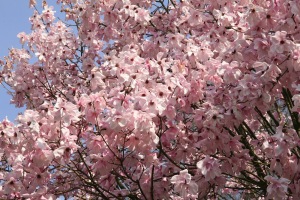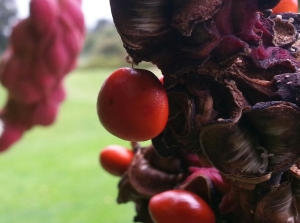You might expect the months of Spring and early Summer would be the time when Magnolias are putting on their best show, but some also look fantastic during Autumn too, like the one we’re going to be looking at in this week’s blog. Our Magnolia sargentiana var robusta tree can be found just past the Italian Loggia building at the far end of the garden but it is certainly worth taking a walk to go and see right now, as the pictures throughout this article will no doubt show.
Magnolias are amongst the most primitive of flowering plants and there are around 100 species of Magnolia which grow wild in southeast Asia, in southeastern North America, and in high land areas in the north of South America. All can make good garden plants but they are naturally dependent on climate and conditions. Here at Nymans, our Magnolias seem to thrive nicely, especially this particular one which has reached a grand old height in its current spot, achieving a great shape and form in the process.
Magnolia sargentiana was discovered in 1903 by Ernest ‘Chinese’ Wilson, in the hamlet of Yin-Kou, west of Wa-shan, in the western Sechuan province of China. According to Wilson this was the largest of the Chinese magnolias. In 1908 he returned to Yin-Kow to find that the tall tree had been cut down but he managed to collect seed of other Magnolia sargentiana from the surrounding area, and during that same expedition, he collected seed of the variety robusta. It was named in 1913 by Rehder and Wilson after Charles Sargent – the Director of the Arnold Arboretum in Boston from where Wilson had been sent. The name ‘robusta’ refers to the flowers which are larger and more showy then the standard species, reaching up to 9″ across when fully expanded in some cases.
There are some years when this Magnolia doesn’t flower too well, perhaps because the tree is exhausted after a prolific flowering spell the previous year. This year just gone was a great year for blooms on our tree though, as you can see by the number and size of seed pods, but judging by the flower buds already present, hopefully next year will buck the trend and be another corker too! The pointed buds of Magnolia sargentiana var robusta, like many Magnolias, are covered with attractive silky hairs and are also enclosed in leathery bracts to protect the flowers within.
It is not just the seed pods and flower buds that are winning over our visitors at this time of year however. As you can see from the above picture, the pods themselves are starting to split open to reveal masses of orange Smartie-like seeds inside. To maximise their ripening potential these little jewels hang from the seed pods on thin white umbilicus strands as you can see from the pictures below:
Our tree is thought to be a ‘Wilson Original’ in that it was grown from the first batch of seeds that the great plant hunter sent to this country from his expedition, and then planted here at Nymans in the very early 1920’s. It is also important to Nymans because it is one of the parent plants that brought about Magnolia ‘Anne Rosse’, Anne being the grand daughter of Ludwig Messel who purchased Nymans in 1890.
With so many huge seed pods hanging from the tree, more than the gardeners here can remember seeing for quite some years, we are a little worried that any high winds might be too much for the boughs to handle and may cause them to break or snap off. Luckily that hasn’t been a problem so far though and fingers crossed that it won’t. We think the reason behind the high number of flowers and pods this year may be down to all of the rainfall we experienced last Autumn and Winter combined with good weather for pollinating insects in the Spring and Summer. The tree certainly seems in fine fettle right now, especially when you consider it is nearly 100 years old, as the picture below goes to show:
So the next time you come and visit us here at Nymans, make sure you make your way down to the far end of the gardens and see our stunning Magnolia sargentiana var. robusta tree for yourself. I promise you won’t be disappointed! Of course, there is plenty more to see and do here at all times of the year so to make sure you keep up to date with all that is going on at Nymans, don’t forget you can interact with us on both Twitter and Facebook as well as finding out all the important visitor information via our official website. If you want to be alerted by email when each new Nymans Garden Blog is published, simple click the ‘Follow’ button at the top of this page and carry out the instructions.












